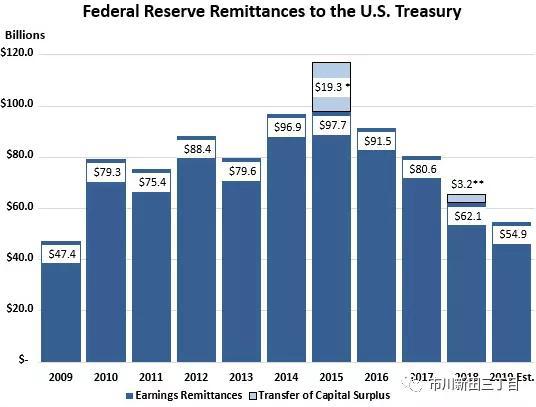
In addition to a lot of smaller activities, the Federal Reserve does two financially huge things: in 2019, it held about $4 trillion in interest-bearing assets, mostly Treasury securities and mortgage-backed securities (MBS); and it owed banks about $1.5 trillion in interest-bearing reserves. Among its other activities, are its reverse-repo activities, and the costs of its own operations. On Friday, the Fed reported its preliminary results for 2019, including how much it paid the banks ($35 billion), how much it paid the counterparties of its reverse repos ($6 billion), how much it remitted back to the US Treasury Department ($54.9 billion), and how much it paid in dividends.
不算那些数不过来的小事,2019年联储干的大事有两件:一是持有了总额约为4万亿美元的附息资产,其中绝大多数是美国国债和按揭质押债券,二是吸收了美国各家商业银行上存的约1.5万亿美元的存款准备金(联储需要为这些以存款形式存在的存款准备金支付利息)。其他方面的经营活动包括,逆回购和维持自身运营所需的花费。上周五,联储公布了其2019年的初步运营报告,包括其付给各家商业银行多少存款利息,在逆回购操作中向交易对手支付了多少利息,还给美国财政部多少钱(还了549亿美元)以及支付了多少股息。
The Revenues:
收入方面
The Fed earned $102.8 billion in interest income from the Treasury securities and MBS it held in 2019. This was down 8.5% from the $112.3 billion it earned in 2018, in part because Quantitative Tightening, with extended into July, reduced the pile of interest-bearing assets on the Fed’s balance sheet. It also earned $444 million from “services.”
联储在2019年里因持有美国国债和按揭质押债券而从美国财政部手中得到1028亿美元的利息收益,与2018年1123亿美元的利息收入相比缩水了8.5%,部分原因是因为实施了量化紧缩,一直持续到2019年7月,导致资产负债表上的附息资产总量出现减少。此外,联储还通过“提供服务”而获得4.44亿美元。
The Expenses:
开支方面
What it paid the banks: The Fed paid its member banks (there are over 3,000 of them) interest due on required and excess reserves that banks have on deposit at the Fed. Those reserves on deposit at the Fed — liabilities on the Fed’s balance sheet — averaged about $1.5 trillion in 2019, but had been declining through September. Also, starting at the end of July, the Fed cut rates three times, including the rate it pays on reserves. So the interest the Fed paid the banks on these reserves fell 9.1% from a year earlier, to $35.0 billion.
付给商业银行的存款利息:联储为加入联邦储备银行体系的3000多家成员银行向美联储上缴的法定存款准备金和超额存款准备金支付存款利息。这些在联储资产负债表的负债科目中体现出来的存款准备金在2019年的平均余额约为1.5万亿美元,但是自2019年9月起就一直在减少。此外,联储自2019年7月末开始连续降息三次,联储支付给存款准备金的利率水平也在调降之列。因此2019年联储向存款准备金支付的利息比2018年减少了9.1%,总额为350亿美元。
Note that if banks had not deposited those funds at the Fed, they would have likely bought Treasury securities for at least part of it and would have earned about the same or a higher rate of interest from the US government. When banks sit on large amounts of reserves, they’re going to try to make money off them, one way or the other.
值得注意的是,如果这些准备金存款没有上缴给联储,商业银行至少会将其中一部分用于买入美国国债,总收益率应等于或高于美国政府给的利率水平。当商业银行坐拥大量的存款准备金,总想找个办法以钱生钱。
What the Fed paid its reverse-repo counterparties: The Fed paid $6.0 billion in interest to its counterparties on securities it sold under reverse repurchase agreements (the opposite of repos). Reverse repo balances are liabilities on the Fed’s balance sheet. The Fed has been doing reverse repos for a long time. Balances started surging in 2014, peaking at over $500 billion. Then in 2017, balances started declining. In 2019, they averaged around $270 billion.
逆回购项下支付给交易对手的利息:2019年,联储在逆回购交易项下向交易对手支付了60亿美元的利息。在联储的资产负债表上未到期的逆回购交易余额体现在负债方。联储做逆回购的历史已经很长了,逆回购交易的余额在2014年开始暴涨,峰值超过了5000亿美元。这之后,逆回购交易的余额开始在2017年出现缩水,2019年的余额平均为2700亿美元左右。
The Fed’s own operating expenses amounted to $4.5 billion.
联储自身运营的花费:为45亿美元。
Other expenses: The Fed also incurred expenses of $837 million related to producing, issuing, and retiring currency; $814 million for Board of Governors expenditures; and $519 million to fund the operations of the Consumer Financial Protection Bureau.
其他开支:联储还有8.37亿美元的花费与制造、发行和回收货币有关,联储理事会的开支为8.14亿美元,消费者金融保护局的运营经费为5.19亿美元。
Net income and where it went:
净收益及明细
After it was all said and done (income minus expenses), the Fed had an estimated net income of $55.5 billion in 2019. Final data will be published in its audited annual report.
把所有收支金额汇总即收入减去支出后,联储统计出来的2019年净收益为555亿美元,数据将发布在其经审计的2019年年度报告中。
Every year, the Fed remits nearly all of its net income to the US Treasury department. For 2019, it remits $54.9 billion. This is down from a remittance of $65.3 billion for 2018 (chart vie the Federal Reserve):
联储每年会将其几乎全部净收益移交给美国财政部,2019年的移交额为549亿美元,低于2018年的653亿美元。

The circularity: The US Treasury borrows money to fund the US deficit. This borrowing takes the form of selling Treasury securities. The Fed buys and holds a chunk of this debt, and like others gets paid interest on this debt. After it funds its operations and pays interest to the banks and counterparties, the Fed then pays the US government back what’s left over.
联储的收入从哪来?利润到哪去?美国财政部要借钱弥补预算赤字,借钱是通过发行国债的方式进行的。联储购买并持有了相当一大部分新发的美国国债,并像其他持有人一样也得到国债利息收入。在满足自身运营的资金需要并向商业银行和逆回购的交易对手支付融资利息后,营业收入中剩余的部分被联储返还给了美国政府。
Dividends to its member banks. The 12 regional Federal Reserve Banks are private companies whose shares are owned by the financial institutions in their districts. The Fed pays dividends to the shareholders of the 12 regional FRBs. These dividend payments are determined by federal statute. For 2019, the Fed paid $714 million in dividends to these financial institutions.
向成员银行支付股息:美国联邦储备银行体系是由12家区域性联储分行组成,从法律上讲每家分行都是私有企业,其股份由所在地区的商业银行等金融机构持有。联储向12家区域分行的股东支付股息,股息的发放是以联邦法令为依据的。2019年,联储向各家股东支付了总额为7.14亿美元的股息。
Though $714 million in dividend payments sounds like a lot, but compared to the $35 billion the Fed paid the banks in interest, it’s practically a rounding error. Anything denominated in millions is a rounding error at the Fed where the big things are denominated in trillions. That’s the times we live in.
尽管7.14亿美元的股息听上去不少,但与联储向商业银行支付的350亿美元利息相比,就像是在四舍五入的时候算错了零头。对于动不动就以多少万亿美元来算账的美联储来说,任何以百万美元表示的数字都算是零头。时下就是如此。
免责声明:自媒体综合提供的内容均源自自媒体,版权归原作者所有,转载请联系原作者并获许可。文章观点仅代表作者本人,不代表新浪立场。若内容涉及投资建议,仅供参考勿作为投资依据。投资有风险,入市需谨慎。
责任编辑:郭建